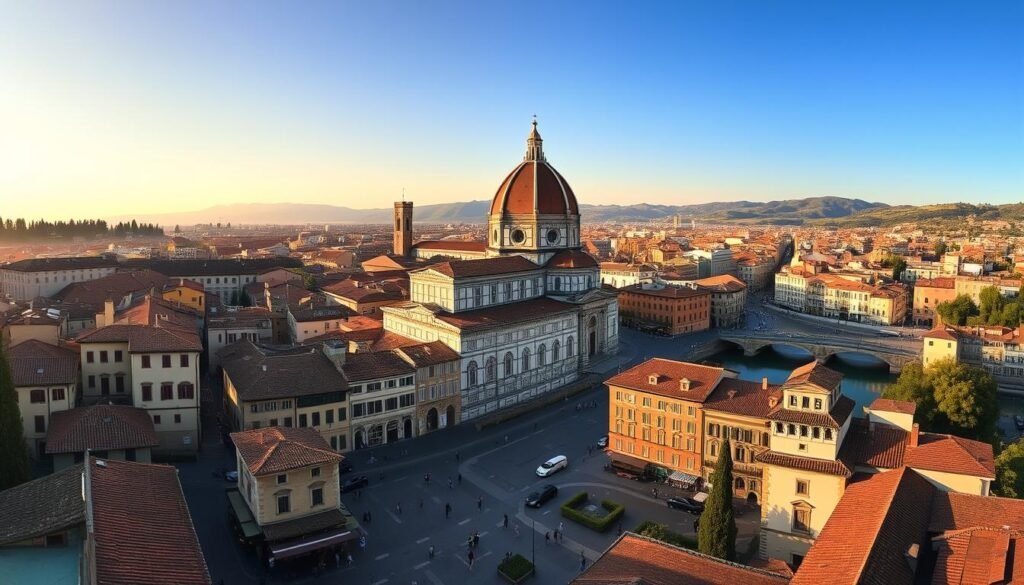Surprising fact: over 10 million visitors crowd this city each year, making careful planning essential for a smooth trip.
I wrote this guide after many visits so you can hit the icons without feeling overwhelmed. I focus on top-value experiences, smart ticket strategies, and my favorite views across the historic center.
Book ahead for major sites like the Accademia, the Uffizi, and Duomo climbs; guided tours often add access or skip-the-line perks that save precious time.
I pair the art that made this place famous with food stops and quieter vantage points. You’ll find when I go for photos, which passes I pick, and how I shift plans when crowds surge.
Key Takeaways
- Reserve major museum and Duomo slots well ahead.
- Choose guided tours for access and saved time.
- Plan sunsets at Piazzale Michelangelo or quieter San Miniato al Monte.
- Mix top museums with food markets and short walks.
- Pack a flexible schedule so your visit flows, not stalls.
Start at the Duomo Complex: Santa Maria del Fiore, Dome, and Bell Tower
I always begin at the Duomo complex because its scale and stories set the tone for the whole visit. Plan your tickets first and lock a timed slot; climbs and specialty tours often sell out well ahead.
How I plan my visit: passes, time slots, and avoiding crowds
I book climb reservations early and arrive about 20 minutes before my slot to clear security. The cathedral nave is free, but lines can wrap around the church. Note the Duomo closes on Sundays and certain religious hours.
Climb choices: Brunelleschi’s Dome vs. Giotto’s Bell Tower
I usually pick a single climb if I’m short on time. The Dome offers a unique interior path and engineering context. The bell tower gives easier rest points and the classic views of the dome roofline.
Don’t skip these: Baptistery, Crypt, and Museo dell’Opera
Highly recommend a quick stop at the Museo dell’Opera del Duomo for background on the art and engineering. The Baptistery retains its mosaics despite scaffolding, and the Crypt of Santa Reparata is a peaceful, older layer beneath the complex.
- Book tickets with timed entry first.
- Choose one climb if short on time.
- Keep a small backpack for faster security.
See Michelangelo’s David at the Galleria dell’Accademia
Seeing David is one of the city’s one best moments, but the Accademia is small and fills fast. I treat reservations like a firm plan: buy early, keep your confirmation handy, and expect strict timed entry.
My ticket strategy for sold-out days and long lines
I book tickets the moment my dates lock. If the official site is sold out, I pick a skip-the-line or guided tour; third-party combined tours often save the day on short notice.
On arrival I swap my online voucher for a paper ticket at the nearby booth, then join the exact time-slot line. Staff admit groups to the minute, and security works like an airport—large bags slow you down.
- I keep my bag small and my camera ready; David’s hall gets crowded and photo spots rotate quickly.
- I allow at least an hour: after David I linger with the Slaves/Prisoners, plaster casts, and the small musical instruments room.
- If entry proves impossible, I still visit the replica in Piazza della Signoria and pivot to a last-minute tour if weather or lines ruin my hours.
Pro tip: aim for the first openings for shorter lines, and pad extra time for afternoon visits when crowds and photo queues swell.
Immerse Yourself in Renaissance Masterpieces at the Uffizi Gallery
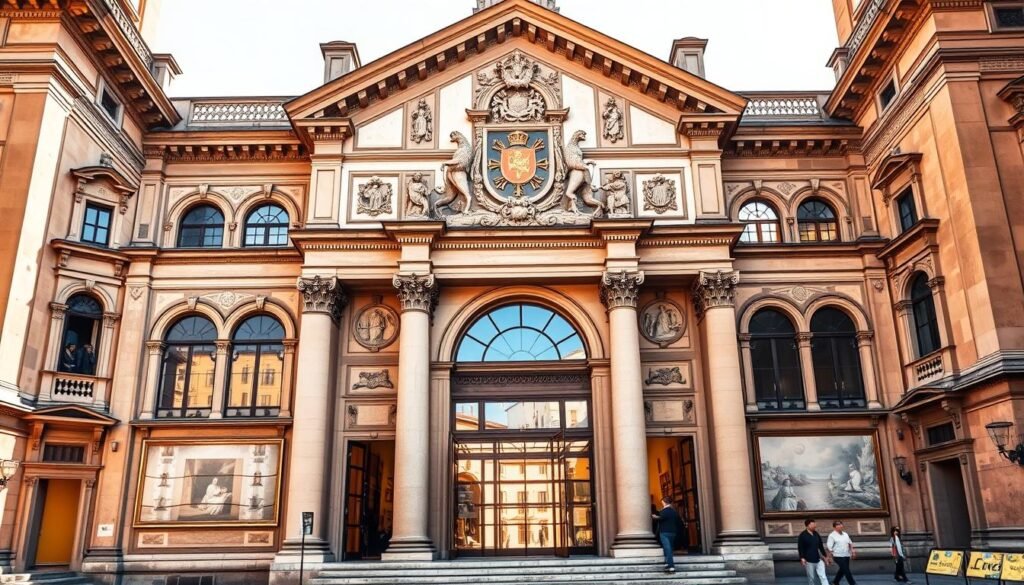
I always start my Uffizi visit with a quick map scan so I can hit the highlights before the crowds swell. Booking ahead is essential; the museum sells out often and skip-the-line options save precious hours.
My must-see works: Botticelli, Leonardo, Caravaggio, and more
Must-sees: Botticelli’s Birth of Venus and Primavera, Leonardo’s Annunciation, Raphael, Titian, and Artemisia Gentileschi. I aim for icons first, then drift downstairs where rooms feel calmer.
Why I book a guided tour
A guide brings context fast and keeps the route efficient. For short visits I book a small-group tour or a combo tour with the Accademia to streamline tickets and transit.
“A skilled guide turns each canvas into a story; the right tour cuts wait times and deepens the visit.”
| Plan | Duration | Benefit |
|---|---|---|
| Highlights pass | 2 hours | See icons quickly |
| Leisure visit | 3–4 hours | Linger in quieter rooms |
| Combo tour | Full morning | Smooth tickets, guided context |
Practical tips: keep a light bag, have your entry QR code ready, and plan rainy-day extra time for river views across the Arno. I highly recommend booking tickets and a guide weeks ahead.
Climb a Historic Tower for the Best Views of Florence
![]()
For one of the clearest panoramas, I head up a historic tower that frames the skyline like a living postcard.
Arnolfo Tower at Palazzo Vecchio: my favorite Duomo view
The Torre di Arnolfo gives a close-up side view of the Duomo that feels uniquely intimate. I find this angle ranks as one best vantage for the dome curve against the rooftops.
Book carefully: online you must choose a tower ticket rather than museum access. The climb has its own fee and a different schedule from the exhibits.
I usually visit the free courtyard first, then start the stairs. A short guided history intro at the Palazzo helps me spot details in the square before I climb.
Other stellar viewpoints: semi-secret towers and seasonal options
Several smaller towers open only part of the year. I check seasonal openings ahead and plan climbs for clear light and quieter moments.
On hazy or windy days I wait for a break in conditions so my photos show the city best. When tower-hopping, I pack water and space my climbs for leg breaks.
- Timing: choose early or late slots for softer light and fewer people.
- Tickets: confirm tower access, not just museum entry.
- Tour tip: a short guided preview adds history and changes how I read the panorama.
Stroll the Ponte Vecchio and Learn Its Medici Backstory
![]()
I time bridge walks for early hours; fewer people mean better photos and easier browsing. I aim for dawn or right after rain when the shops feel calm and the river glitters.
The bridge has deep history. Likely first built by Romans and rebuilt in the 14th century, it once held butchers. The Medici swapped them out for jewelers so the Vasari Corridor above would stay clean and discreet.You can lean about best-time-to-visit-portugal
The Ponte Vecchio was the only local bridge spared bombing in WWII; the Germans destroyed nearby access points rather than the span itself. That surviving arc gives the bridge a strange, proud glow today.
My shopping rule: set a budget and compare prices. Florence’s gold standard is 18k and shops on the bridge often charge a premium. I browse with a plan so I leave with a small, wearable memory rather than buyer’s remorse.
When I go for quieter photos and better browsing
- I shoot from the bridge and from the riverbanks for varied angles.
- If crowds swell at sunset, I wait and return later for lit reflections.
- Bad weather is fine: I duck into a shop or cross to Oltrarno for a different view.
| Best time | Best for | Note |
|---|---|---|
| Early morning | Quiet browsing, photos | Fewer people, softer light |
| After rain | Reflections, calm shops | Shops reopen with fewer crowds |
| Sunset | Atmosphere, crowd energy | Very busy; higher prices |
On a short tour or when I have only a few days, Ponte Vecchio feels like the place to breathe. It ranks as one of my memories from one Florence.
Hang Out in Piazza della Signoria: Art, People-Watching, and Palazzo Vecchio
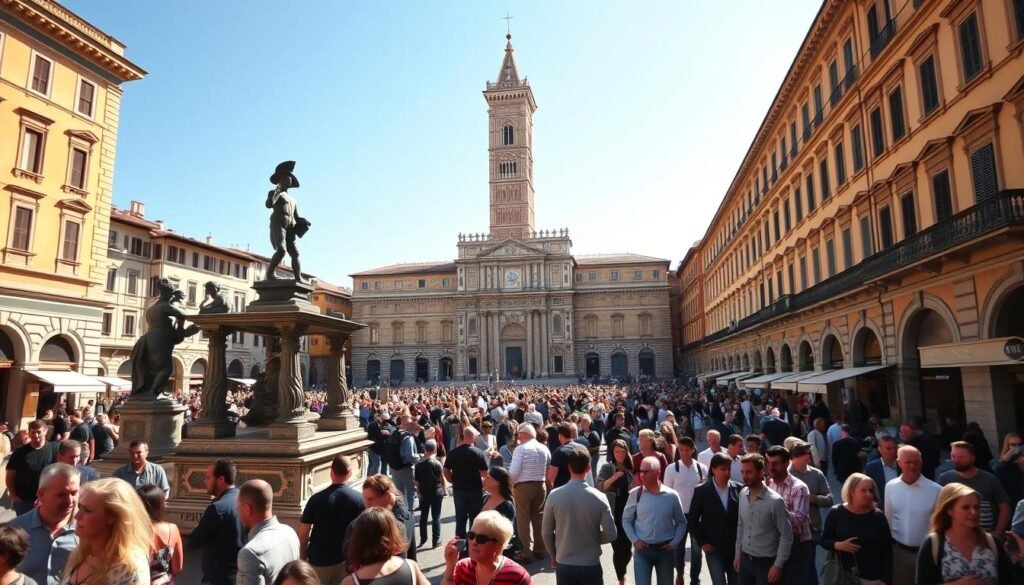
I like to spend unhurried moments in the piazza, watching street life fold around centuries-old sculptures.best-time-to-visit-ireland
The square is the civic heart near the Uffizi, with the Loggia dei Lanzi offering free, open-air viewing of dramatic marble and bronze works.
My routine: I sit on the Loggia steps, snack, and watch buskers and vendors while the Neptune Fountain and the replica of David anchor the space.
I always step inside the Palazzo Vecchio courtyard for a quick look. That helps me decide whether I have energy for the museum or a tower climb later.
The piazza shifts as day becomes night. At night the lighting softens, small groups gather, and the square feels quieter and more cinematic.
- Pro tip: use this central hub for routing — the bridge and eateries are a short walk away.
- Stay aware: keep belongings close; demonstrations and crowds pop up at any time.
- For more history and practical details, check this Piazza della Signoria guide.
Catch Sunset at Piazzale Michelangelo or San Miniato al Monte
![]()
I pick the hill that fits my mood: lively and social, or quiet and reflective. Both spots give classic panoramas and memorable light as the day closes.
My sunset game plan (and where to hear Gregorian chants)
Piazzale Michelangelo offers iconic views and a festival vibe. I allow extra time there because buskers and the replica David draw crowds fast.
When I want breathing room, I keep climbing up to San Miniato al Monte. The church sits higher, the terrace feels quieter, and monks sing Latin and Gregorian chants at set times — check the church schedule if you want that moment.
“Catch the chant between photos; it turns a busy view into a surprising calm.”
- I stop in the Rose Garden on hot days for shade and a few hidden skyline angles.
- If the sky is hazy, I still go — soft light makes great views.
- Bring a light layer; winds pick up after sunset and the walk down offers more night city shots.
- For fewer people, consider a sunrise run; similar views with a fraction of the crowd.
Explore the Pitti Palace and Boboli Gardens like a Medici
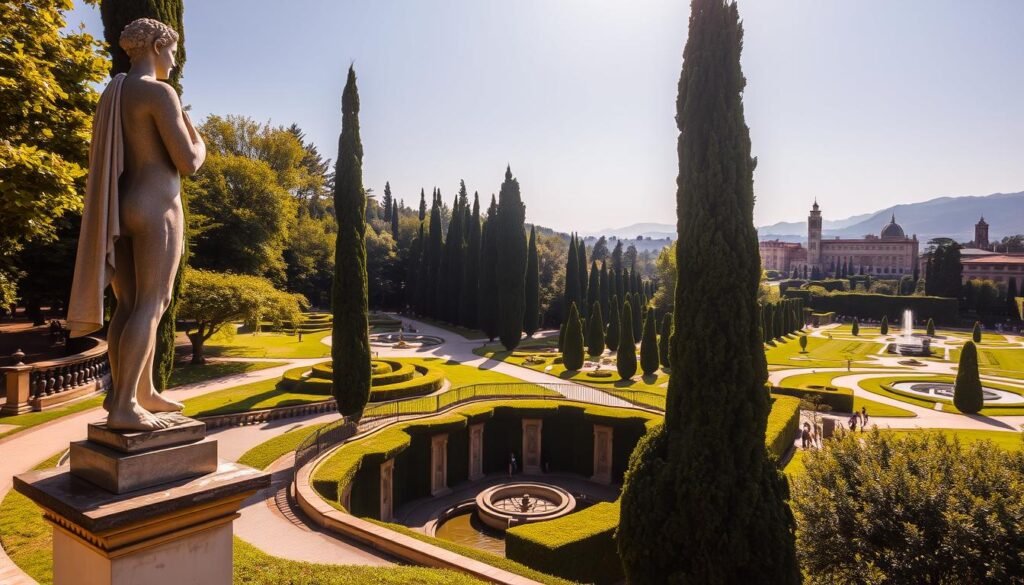
I treat Palazzo Pitti as a layered visit: grand rooms first, open air after. That order helps me feel the palace history, then breathe into the garden designs.
What I prioritize inside before heading out
Palatine Gallery is my top stop for the big canvases and court portraits. I move quickly through the royal apartments and peek into the Palatine Chapel to sense how the Medici family lived and ruled.
I usually buy a combined tickets option that bundles the exterior gardens and, when offered, the Bardini Gardens. That saves time and makes the whole day smoother.
My favorite garden vantage points and a museum note
In the boboli gardens I head straight for higher terraces. My favorite panorama sits near the Casino del Cavaliere, beside the Porcelain Museum entrance.
As of 2025 the Porcelain Museum remains closed for updates, but the terrace there still offers superb views. I plan a loop, take a water break, and use shaded lanes at midday.
“When paths crowd, I slip into side alleys — quieter statues and framed city glimpses reward the detour.”
| Spot | Why I go | Best time |
|---|---|---|
| Palatine Gallery | Masterpieces and court rooms | Morning |
| Royal apartments | Medici layers and decor | Late morning |
| Casino del Cavaliere terrace | Top skyline panorama | Afternoon light |
| Bardini staircase | Postcard Duomo framing | Golden hour |
- I wrap at Bardini when included — the steps make a memorable final place.
- If main routes fill, I veer to quieter alleys for layered city views and calm statues.
- Timed entry helps in high season; check schedules and allow extra time for wandering.
Eat Your Way Through Florence: Tuscan Dishes I Always Order
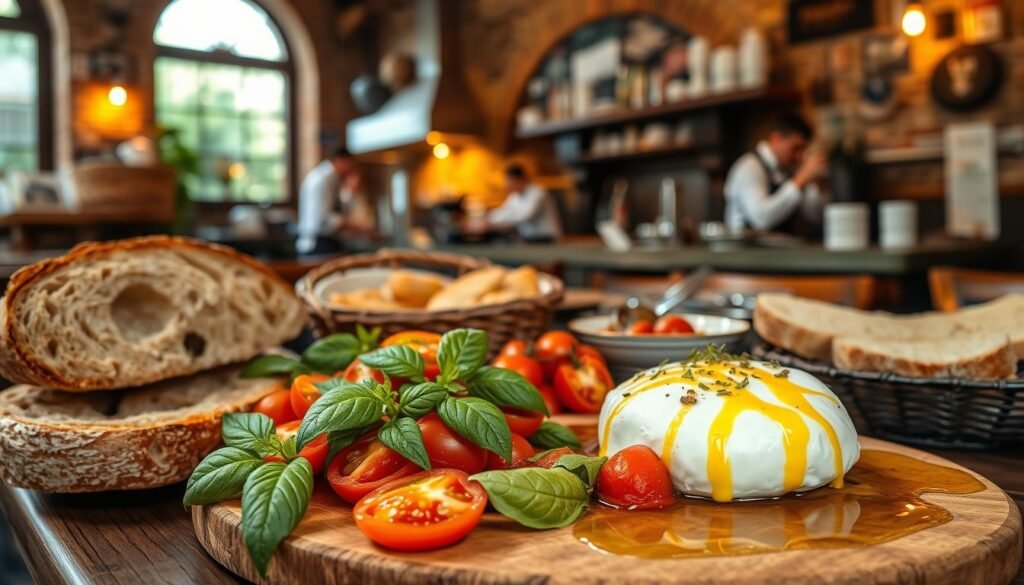
My meals here anchor the day: generous bowls, grilled steaks, and cheeky sips that feel like local rituals.
I start with ribollita or pappa al pomodoro — bread-thickened soups that taste of the countryside. They warm me up and stretch a short lunch into slow conversation.
Ribollita, pappa al pomodoro, bistecca, and wild boar pasta
For pasta, tagliatelle al cinghiale is my pick. The gamey ragu pairs perfectly with a glass of Chianti.
Bistecca alla fiorentina is meant for sharing and served very rare. I order it after a long walk and split it with family or a friend.
Wine windows (buchette del vino): my quirky, can’t-miss sip
I hunt down wine windows and grab a quick pour. They date back to a 17th-century plague and feel like a small slice of history.
- I highly recommend leaving room for gelato daily; look for muted colors in metal tubs.
- I eat early or late by about half an hour to skip crowds and find better service.
- If a main street looks perfect, I circle a block for a quieter, more authentic place and price.
“Good food here links art and everyday life — simple, bold, and made to share.”
Join a Food Tour or Cooking Class to Level Up Your Trip
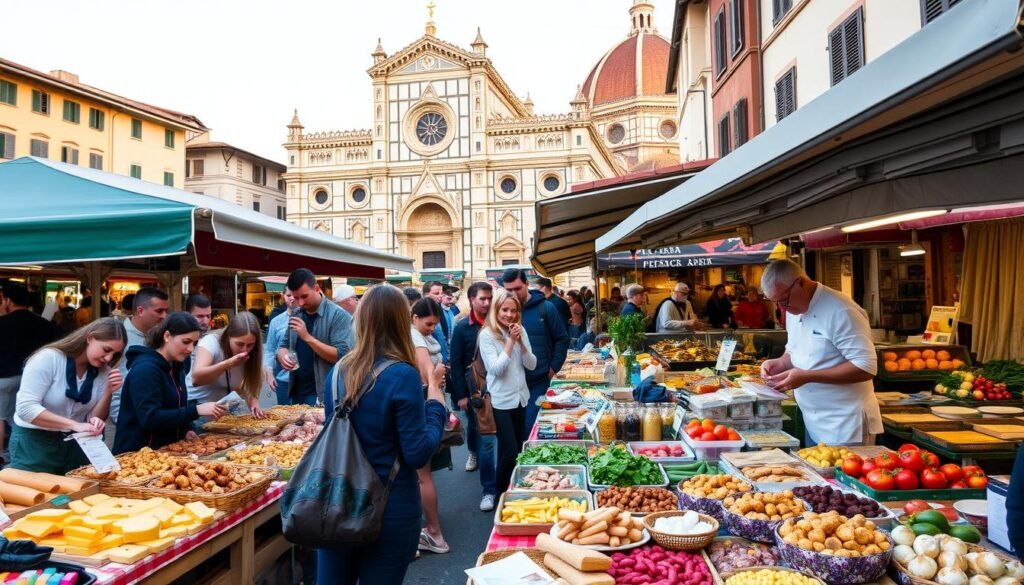
An evening spent sampling local plates and pours quickly taught me where the real neighborhood favorites hide. I book a guided tour within my first 24–48 hours so I get directions and a few must-try restaurants for the rest of my days.
The evening food tour I loved
My favorite walk moved through Oltrarno and Santa Croce. It mixed crostini, a bite of bistecca, and gelato, with a pour through a wine window for fun.
Hands-on classes and villa workshops
For hands-on learning I pick a market-to-kitchen class that covers fresh pasta and tiramisù. Pizza-and-gelato sessions are quick wins when I have little time and want a family-friendly option.
“A great guide turns tastes into quick lessons about neighborhood life.”
| Option | Best for | Typical time | Dietary notes |
|---|---|---|---|
| Evening food tour | Local tips, tastings | 2–3 hours | Often flexible |
| Market-to-table class | Skill building, recipes | 3–4 hours | Gluten-free options exist |
| Villa workshop | Scenic cooking | Half day | Book early for dates |
I highly recommend a tour early: the guide’s tips save time and lift your whole trip. Check class notes for gluten-free or other dietary needs before booking.
Market Hopping: Mercato Centrale, San Lorenzo, and Sant’Ambrogio
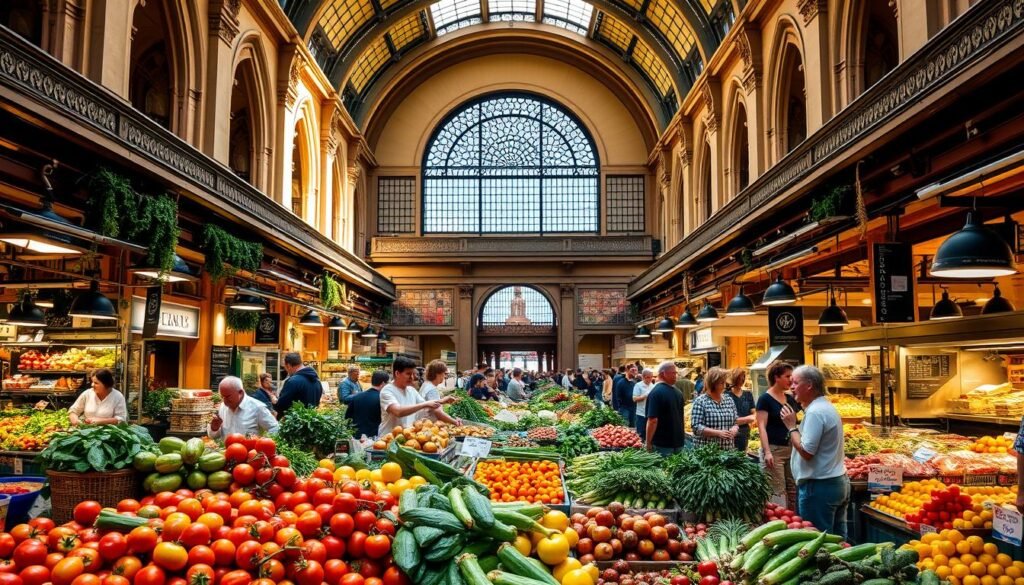
I plan at least one market visit—early light, loud stalls, and honest flavors tell me more than a map.
Mercato Centrale has two moods. The ground floor sells fresh produce, cheese, and raw ingredients that make my shopping list jealous. I arrive early for photos and the best stalls.
The upper floor is a prepared-food hall aimed at visitors. Prices are higher, so I grab a quick panino there only if I’m short on time.
San Lorenzo is where outdoor stalls sell belts and wallets. For high-end leather I prefer a vetted artisan or the Scuola del Cuoio; outdoor bargains vary in quality.
Sant’Ambrogio feels calmer. Fewer tourists, more locals, and a nearby flea market where I hunt small vintage finds that fit in my carry-on.
- I buy edible souvenirs: biscotti, spice blends, olive oil tins, and vacuum-sealed cheese (check customs).
- I time visits for weekend artisan fairs in Santo Spirito when I can meet makers and pick unique gifts.
| Market | Best for | When I go |
|---|---|---|
| Mercato Centrale (ground) | Fresh produce, photos | Early morning |
| Mercato Centrale (upper) | Quick bites, variety | Lunch rush |
| San Lorenzo stalls | Affordable leather goods | Midday browsing |
| Sant’Ambrogio | Local vibe, flea finds | Late morning |
Gelato I Could Eat Every Day
A great gelato can rescue a long museum day, so I make tasting a short daily habit.
I judge gelato by the basics: muted colors, metal lidded tubs, and seasonal flavors. Avoid neon scoops piled in plastic bins — they usually signal artificial ingredients.
My go-to stops: Gelateria dei Neri is my one best pick for reliable texture and creative flavors. Vivoli is where I head for sorbetti or an affogato when I want a classic parlor vibe and a coffee lift. Near the center, Festival del Gelato is a handy place for a quick cup between museum runs.
- I love mixing one fruit and one cream flavor — dark chocolate with pear is a winner for me.
- If lines are long, I wait; great gelato is worth five minutes and often tastes better when fresh.
- Keep an eye on presentation: metal tubs and subtle hues mean real ingredients and careful craft.
Short ritual tip: grab a cone in the afternoon, sit on a nearby bench, and let a small scoop mark a slow moment in the city. It turns busy days into a simple, sweet memory.
Go Beyond the Big Three: Santa Croce, Bargello Museum, and Hidden Gems
If I need a reset between must-see sites, I walk toward santa croce and its calm square.
Basilica Santa Croce is the principal Franciscan church here. Inside, the tombs of Michelangelo, Galileo, and Machiavelli anchor a surprising link of art and history.
I linger on the steps and feel the quieter rhythm compared with the Duomo area. The square gives space to breathe and reflect.
The Bargello museum sits nearby in a former jail. It houses seminal sculpture by Donatello and works by Michelangelo. I prefer its pace — fewer tour groups and longer time with each piece.
“A short detour here turns a busy itinerary into a fuller, quieter day.”
- I buy timed museum tickets when I can; they are easy to get and cut waiting.
- For a secret pause, I ride the elevator up to Caffè Oblate and sip while the Duomo peeks over roofs.
- I mix these stops mid-day: less noise, more depth, and a steadier rhythm for the rest of the city.
| Spot | Why I go | Best time |
|---|---|---|
| Basilica Santa Croce | Tombs of key figures; peaceful square | Late morning |
| Bargello Museum | Great sculpture, fewer crowds | Afternoon |
| Caffè Oblate | Library roof view of the Duomo | Any time for a short break |
Positioning and Timing: Santa Maria Novella Station, Tickets, and Crowds
I plan tickets and transfers first, then layer sightseeing around confirmed train times. Santa Maria Novella is the main rail hub, so I pick a hotel nearby when I expect day trips. High-speed trains link the city and Milan in about 2.5 hours, and being close saves early-morning stress.
How I book: Accademia, Uffizi, Duomo climbs, and tours
I reserve Accademia, Uffizi, and Duomo climb tickets first. If I can, I grab an after-hours Duomo tour — it avoids peak crowds and makes photos easier.
When I visit: months, hours, and rainy-day advantages
I favor October and November for fewer lines. I aim for first entry or late slots; rainy hours are perfect for museums when lines shrink.
- Airport transfer: tram (~€1.70) or taxi (~€25) to the center.
- Practical gear: eSIMs for confirmations, cards for purchases, a few euros for tips.
- Plan B: when lines balloon, a short guided tour often gets me inside faster.
“Anchor near Santa Maria Novella and let timing work for you — it turns rushed trips into calm days.”
Best Day Trips from Florence for First-Timers
A well-chosen day trip can turn a week in the city into a richer, more layered visit.
I often start with a classic pairing: Pisa and Lucca. It’s easy by train and gives a sharp contrast — the Leaning Tower photo op, then a mellow ride or walk on Lucca’s intact walls. For many, this is one best day trip.
Pisa & Lucca, Chianti, and the Cinque Terre
If I crave the countryside, I pick a Chianti tour that visits two wineries, offers olive oil tastings, and leaves time for a hill town stroll.
Cinque Terre shines on a guided tour; a good guide hits several villages without wasting connections. I check train timetables when I travel solo and build in buffer time for a long lunch rather than rushing photos.
“In peak months, reserve tours early—small-group options fill first.”
| Trip | Travel | Why I pick it |
|---|---|---|
| Pisa & Lucca | Train | Iconic sights plus calm walls |
| Chianti wine country | Minivan tour | Wineries, olive oil, rolling hills |
| Cinque Terre | Guided coastal tour | Multiple villages without transit stress |
| Milan (day) | High-speed train | Urban contrast if you start very early |
I usually limit myself to one day trip mid-week and maybe a second if my schedule allows. For extra planning notes and options, I check this best day trips guide.
Conclusion
Smart timing and a few guided hours saved me more sightseeing time than any checklist ever could.
I wrote this short guide so your visit florence stretches into calm moments, not long lines. Book major tickets, pick a couple guided tours, and set one sunset as a daily anchor.
Hit the icons first — Duomo complex, David, Uffizi — then balance days with market breaks, towers, and a nightly gelato ritual. When I need quieter space, I slip into Santa Croce or climb to San Miniato al Monte for one best view of the city.
I highly recommend saving a day for the countryside or coast. Pisa & Lucca, Chianti, or Cinque Terre each change the pace of your trip and give a richer sense of place.
Above all, give yourself time between sights. Some of Florence’s best moments arrive in the little pauses.


